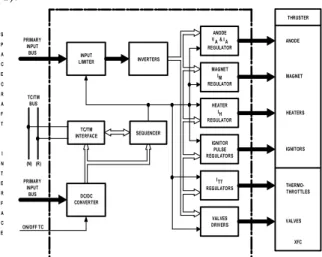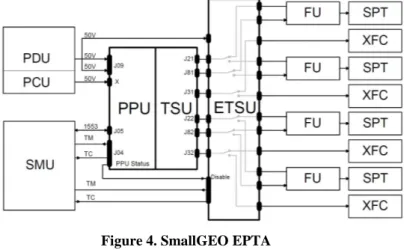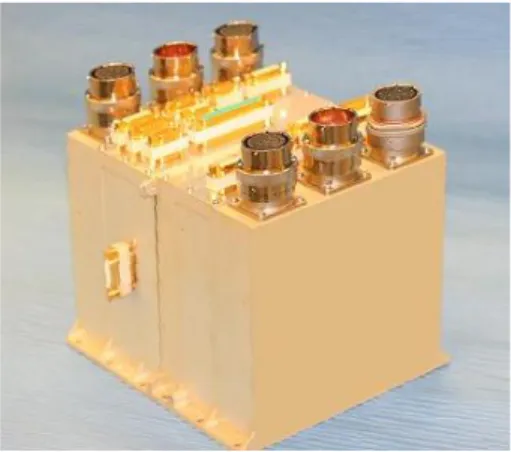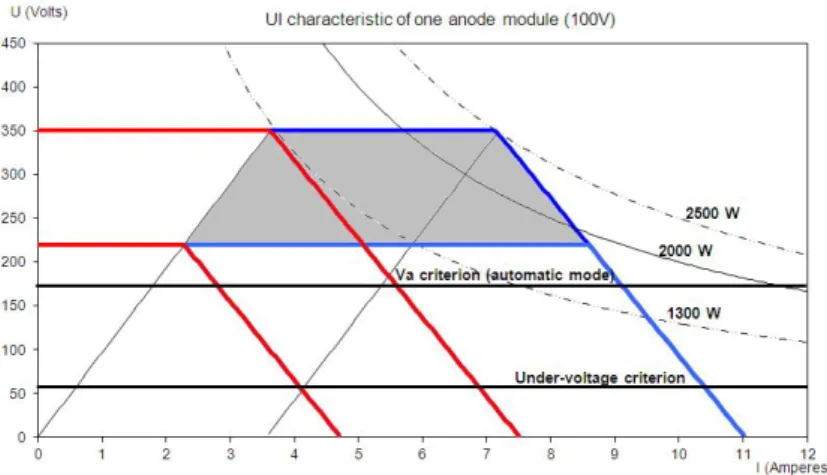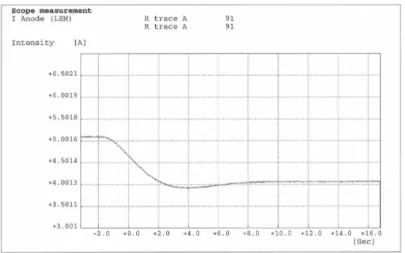1
Power Processing Unit Activities
at Thales Alenia Space Belgium (ETCA)
IEPC-2015-224
Presented at Joint Conference of 30th International Symposium on Space Technology and Science 34th International Electric Propulsion Conference and 6th Nano-satellite Symposium,
Hyogo-Kobe, Japan July 4 – 10, 2015
Eric Bourguignon1, Stéphane Fraselle.2, Thierry Scalais3 and Jean-Marc Defise4 Thales Alenia Space Belgium (ETCA), Mont-sur-Marchienne, B-6032, Belgium
Abstract:
Since 1996, Thales Alenia Space Belgium (ETCA) designs, develops andproduces Power Processing Unit (PPU) to supply Hall Effect Thrusters. The first qualification model, developed for the 50V bus Stentor program, has supplied during 8900 hours an SPT-100 thruster in a vacuum chamber simulating space environment. Qualified for the 100V Spacebus 4000 platform, the 100V PPU and Filter Unit (FU) EQM have cumulated 6300 hours ground operation with a PPS1350-G thruster. Twenty eight PPU Mk1 flight models were delivered for the Stentor, SES, Smart-1, Intelsat, Inmarsat, Eutelsat, AlphaSat, Yahsat, Direct-TV, Sky Brasil and Amos satellites. In October 2005, the Smart-1 spacecraft reached the Moon after 4958 hours of cumulated operation of the PPU and its PPS1350-G thruster. Sixteen PPU’s currently in flight for North South Station Keeping on eight telecom satellites have cumulated more than 28 800 hours flight operation in May 2015. The PPU Mk1 production continues with seven PPU Mk1 flight models currently ordered. On the SmallGEO platform, one Electric Propulsion Thruster Assembly (EPTA) branch has to drive one out of four SPT-100 thrusters. As the PPU drives one out of two thrusters, TAS-B has developed and qualified an External Thruster Selection Unit (ETSU) to be associated to a PPU. Two flight sets (PPU+ETSU) were delivered for SmallGEO. In order to propose a more competitive product, TAS-B has developed and qualified, for the 100V bus platforms, the PPU Mk2, dedicated to Hall Effect Thrusters up to 2.5kW. The PPU Mk2 EQM was successfully coupled with the SPT-100, PPS1350 at 1.5kW and 2.5kW. PPU Mk2 flight models are under production: eight ordered and four anticipated. To reply to the market demand to use Electrical Propulsion for Orbit Raising, TAS-B is developing the PPU Mk3 dedicated to 5kW Hall Effect Thrusters. The PPU Mk3 development, based on the PPU Mk2 heritage, was consolidated by a successful coupling test of the 5kW Anode supply and FU breadboards with the SPT140-D thruster at Fakel facilities in October 2014. The first PPU Mk3 flight models are already ordered for delivery in 2016. This paper presents an overview of the Power Processing Unit activities at TAS-B, including PPU Mk1 flight heritage, PPU Mk2 coupling tests and PPU Mk3 development.
Nomenclature
EPS = Electric Propulsion System
EPTA = Electric Propulsion Thruster Assembly ETSU = External Thruster Selection Unit
1 PPU Product Manager, eric.bourguignon@thalesaleniaspace.com 2 PPU Mk3 Technical Manager, stephane.fraselle@thalesaleniaspace.com 3 PPU Senior Technical Expert, thierry.scalais@thalesaleniaspace.com 4 PPU Programmes Manager, jean-marc.defise@thalesaleniaspace.com
FU = Filter Unit
HPPU = High Power Processing Unit PPU = Power Processing Unit SPT = Stationary Plasma Thruster TSU = Thruter Selection Unit XFC = Xenon Flow Controller
I.
PPU main functions
The PPU is composed of the following modules (see Fig. 1):
♦ Interface on the Primary input power bus, insures main bus protection, voltage level conversion and galvanic isolation required by the SPT supplies.
♦ SPT power supplies, the 4 types of electrodes of the Stationary Plasma Thruster (anode, magnet, heater, ignitor) are supplied according to their specific power profile.
♦ XFC power supplies, PPU supplies the Xenon Flow Controller: opens or closes the xenon valves and controls the discharge current by the regulation of the xenon flow via the thermothrottle power supply.
♦ Sequencer, insures the automatic control and the survey of the thruster operation: start-up, stop, regulated thrust, failure recovery, ...
♦ TC/TM interface with the satellite communication bus.
II.
PPU Mk1
The main characteristics of our current PPU Mk1 product are summarised hereunder:
♦ Dedicated to SPT-100 and PPS1350-G Hall Effect Thruters.
♦ Compatible with 50V or 100V regulated input power bus.
♦ Maximum Anode Power : 1500 W.
♦ Includes SPT and XFC power supplies.
♦ TC/TM plug-in module available for MIL-STD-1553, ML16-DS16 and OBDH-RS485 (RUBI) communication busses.
♦ Can be equipped with or without a switching module (called TSU for Thruster Selection Unit) allowing to drive one out of two thrusters ; this module is typically used for North-South station keeping application on geo-synchronous satellite.
♦ Efficiency in nominal operating conditions:
• 91.6 % for Vbus = 50V
• 92.4% for Vbus = 100V.
♦ Mass for one PPU including TSU: 10.9 kg.
♦ Dimensions: 390mm x 190mm x 186 mm (LxWxH).
♦ Fully qualified according to environment specifications of Europeans platforms Eurostar 3000, SpaceBus 4000 and AlphaBus.
♦ 8900 hrs lifetime test in space vacuum conditions coupled with SPT-100 thruster.
♦ 4958 hrs flight experience on Smart-1 launched in September 2003.
ANODE V A & I A REGULATOR MAGNET IM REGULATOR HEATER IH REGULATOR IGNITOR PULSE REGULATORS ITT REGULATORS VALVES DRIVERS THRUSTER ANODE MAGNET HEATERS IGNITORS THERMO-THROTTLES VALVES INVERTERS INPUT LIMITER DC/DC CONVERTER TC/TM INTERFACE SEQUENCER TC/TM BUS (N) (R) PRIMARY INPUT BUS PRIMARY INPUT BUS ON/OFF TC S P A C E C R A F T I N T E R F A C E XFC
Figure 1. PPU functional block architecture
3
♦ Twenty eight flight models already delivered for Stentor, SES, Smart-1, Intelsat, Inmarsat, Eutelsat, AlphaSat, Yahsat, DirecTV, Sky Brasil and Amos.
♦ Components obsolescence has been handled to continue production of PPU Mk1 for 50Vbus; the 100Vbus version of PPU Mk1 is replaced by the PPU Mk2.
III.
FU
In a standard EPS configuration, a Filter Unit (FU) is used between the PPU and each thruster. The aim of the FU is to
♦ provide filtering on the thruster lines, the thrusters behaving as noise generators at high frequencies;
♦ provide stabilization of the anode discharge current in order to avoid degradation of thruster efficiency with quasi-periodic oscillations in the 10-50 kHz range;
♦ limit the radiated emission inside the spacecraft;
♦ limit the conducted susceptibility at PPU level.
To achieve these functions, a passive filtering unit has been designed. The 1.5 kW version of the FU was fully qualified through an EQM programme followed by a PFM. It has been validated with PPU Mk1 and was used for coupling tests with SPT-100 and PPS1350-G thrusters.
Figure 3. FU TAS-B provided the FU's for SES, AlphaSat and Amos.
IV.
PPU SmallGEO
A. PPU SmallGEO Introduction
The Electric Propulsion System (EPS) of the new small geostationary satellite platform “SmallGEO” is based on two redundant Electric Propulsion Thruster Assembly (EPTA) branches (see Fig. 4). Each EPTA branches includes one PPU driving one out of four thrusters. As the TAS-B (ETCA) PPU includes one Thruster Selection Unit (TSU) module performing a 1:2 selection, a new equipment, the External Thruster Selection Unit (ETSU), is developed to be connected in series with PPU output terminals and to perform a 2:4 selection. The configuration with 2 equipments (PPU + ETSU) was preferred to benefit from PPU flight heritage without major PPU mechanical modification to implement additional modules to perform the 2:4 selection.
Figure 4. SmallGEO EPTA
B. PPU SmallGEO Description
The PPU SmallGEO is a modified PPU Mk1. In order to insure compatibility with the requirement of 1.5kW maximum consumption on SmallGEO power bus, the following modifications are implemented on PPU SmallGEO:
♦ The ability to set the anode supply output voltage from 220V to 301V while the voltage was a fixed value on Stentor PPU. Anode voltage may be commanded via a serial data bus TC either in remote mode or in automatic mode.
♦ A new thruster start-up procedure in automatic mode. The differences could be summarised as follows:
• The thruster is ignited with a low anode voltage setting.
• A pre-defined delay (Tlow) after the ignition, the voltage increases to its nominal value (301V).
• The Tlow as well as the low anode voltage and the anode nominal voltage may be modified by TC through the serial data bus.
• The heater supply is turned OFF before the ignition to minimise PPU inrush current peak. C. ETSU Description
The External Thruster Selection Unit is composed of 2 modules (see Fig. 5). As the TSU module integrated in the PPU, each ETSU module includes electro-mechanical latching relays and their drivers to switch PPU SPT and XFC lines to one out of two ways. The ETSU also includes :
♦ Auxiliary Power Supply to directly supply the relay drivers,
♦ TC/TM interface to activate ETSU and perform selection.
♦ Discharge networks connecting floating electrodes of the thruster to ETSU structure. These resistances draw the electrons captured by the thruster electrodes (and their wiring harness) to the satellite electrical ground.
V.
PPU Mk2
A. PPU Mk2 Development
In the frame of AlphaBus extension program and in partnership with the Primes, TAS-B (ETCA) has developed an optimized and more competitive product: the PPU Mk2. The PPU Mk2 addresses SPT-100, PPS1350-G and Hall Effect Thrusters up to 2.5kW and is dedicated to AlphaBus, Eurostar 3000, SpaceBus 4000 platforms. Taking benefit of flight experience, the PPU Mk2 provides 1.6 times more output power (1.5kW à 2.5kW) and more flexibility to thrusters and platforms, with reduced manufacturing cost.
B. PPU Mk2 Objectives PPU Mk2 objectives are:
♦ More competitive product,
♦ Replacement of obsolete parts,
♦ Compliance to current Primes AD’s and ECSS rules,
♦ Dedicated to PPS1350-G, SPT-100 and Hall Effect Thrusters up to 2.5kW.
♦ Dedicated to AlphaBus, SpaceBus 4000, Eurostar 3000 platforms.
• Bus voltage: 100V regulated
• MIL-STD-1553B interface
5 C. PPU Mk2 Description
PPU Mk2 features are:
♦ Anode output characteristic is commandable in the range 220V – 350V, with short-circuit current commandable in the range 5A – 11A, see Fig 6 .
♦ Thruster type may be defined after PPU manufacturing, via external configuration straps.
♦ Standard start-up or low power/low voltage start-up to reduce inrush current may be selected.
♦ PPU is robust to abnormal pressure increased inside satellite up to 1Pa, by mechanical architecture.
♦ Sequencer based on a FPGA provides more flexibility. By
telecommand, the defaults values and major parameters are adjustable, the protections may be inhibited.
♦ Optional magnet trim supply.
♦ PPU Mk2 is composed of 6 modules:
• Primary: input switch for bus protection and DC/DC to supply the low-level
• Anode supply
• Heater and Ignitor supplies
• Thermothrottle and Magnet supplies
• TSU and Valve Driver
• Sequencer
♦ Same baseplate size (390mm x 190mm) and fixation holes as current PPU Mk1, see Fig.7.
D. PPU Mk2 Qualification
A Qualification Model was built and tested. Figure 8 shows the efficiency measurements obtained on the Qualification Model in function of the discharge supply output power at a voltage of 350V with the valve driver and the thermothrottle supply active: above 94.4% up to 2.68kW.
Similarly to PPU Mk1, the PPU Mk2 presents a defined voltage-current slope above the knee current to enable the thruster start-up without risking a locking point at low voltage due to the thruster characteristic. Figure 9 shows the voltage-current characteristic measured on the PPU Mk2 with the anode voltage set at 300V and the knee-current at 5A.
Figure 6. Anode output characteristic
Thruster start-ups were recorded on the Demonstrator Model using a representative thruster simulator based on initially discharged capacitors. Figure 10 presents the output voltage, output and input current during a thruster start-up. During this test, the discharge voltage was set at 300V before the thruster start-up occurred and the knee-current was set at 5.5A. The thruster load after start-up is 5A imposed by a resistive load.
Figure 10 : Thruster start-up
It may be seen that during the thruster start-up test, the discharge voltage initially drops because the thruster consumption is higher than the knee-current. The discharge voltage then recovers its setting value as the discharge current diminishes after the start-up. The discharge current is reflected on the primary bus consumption through the PPU transformer scaling and its power filters. The knee-current setting enables to modify the peak input-current because it changes the peak power output of the PPU.
The PPU Mk2 provides a numerical proportional-integral regulation of the discharge current by acting on the thermothrottle current. This regulation enables to control the thrust despite the pressure perturbations upstream the thermothrottle. The effectiveness of the regulation has been validated with a simulator of the worst-case thermothrottle current to discharge current transfer-function. Figure 11 presents a step response recorded with the PPU Mk2 coupled to the transfer function simulator when the discharge current setting is changed from 5A to 4A. Tests were also performed where a perturbation (sine and triangular) is injected in the transfer-function simulator. The perturbation rejection performance has been measured and is in line with the analysis.
Figure 8: EQM efficiency at 350V Figure 9 : Anode voltage-current characteristic (with voltage setting at 300V and knee-current at 5A)
0 50 100 150 200 250 300 350 0 1 2 3 4 5 6 7 8 9
Discharge current [A]
A n o d e v o lt a g e [ V] 94.2 94.4 94.6 94.8 95 95.2 95.4 95.6 95.8 1500 1700 1900 2100 2300 2500 2700 Eff ic ie nc y [%]
Discharge supply output power [W]
PPU Mk2 EQM efficiency in function of discharge output power
25°C baseplate -25°C baseplate 70°C baseplate
7
Figure 11 : Discharge current step change response
The PPU Mk2 mechanical qualification, including vibration and pyro-shock test is successfully completed. The thermal vacuum qualification tests were concluded by a pressure increase test up to 2Pa to demonstrate PPU robustness to abnormal pressure increase inside satellite. The thermal vacuum campaign has been followed by a complete EMC test campaign including different LISN configurations to cover the SB4000, E3000 and Alphabus platforms. The Qualification Review was successfully held in July 2014.
E. PPU Mk2 Coupling Test
In July 2014, after the Qualification Review, the PPU Mk2 EQM was coupled with a SPT-100 thruster in the Pivoine facility at CNRS Orléans, France.
In October 2014, the PPU Mk2 EQM and FU EQM were coupled with a PPS1350 thruster, in the Snecma facilities at Vernon, France. Three operating points (250V/4.28A, 350V/4.28A and 350V/7A) were characterized. Two harness lengths were tested and no modification of the thruster performances was observed. The PPU Mk2 soft start mode to ignite the thruster was also validated. This mode reduces significantly the PPU inrush current at thruster ignition. Firings at maximum power (2.5 kW) were performed during 3 hours. They have demonstrated good thermal behaviour of the PPU Mk2 and the FU.
VI.
PPU Mk3
A. PPU Mk3 Introduction
Recent studies from telecom satellites manufacturers and even from telecom operators have demonstrated that the use of Electric Propulsion not only for N-S and E-W Station Keeping but also for orbit raising will significantly reduce the costs of the couple satellite-launcher. This evolution to the Full Electric telecom satellites requires higher power thrusters, and thus more powerful PPU, in order to reduce the orbit transfer duration at a value acceptable for the operators. In line with this evolution of the telecom satellites market, the satellite manufacturers foresee the use of Electric Propulsion to perform orbit raising with 5kW-class Hall Effect Thrusters. In response to this demand, TAS-B (ETCA) has started the development of the PPU-Mk3 based on its significant heritage
B. PPU Mk3 Objectives PPU Mk3 objectives are:
♦ Competitive product,
♦ Dedicated to SPT140-D, PPS5000 and XR-5 thrusters.
♦ Dedicated to SpaceBus Neo, Eurostar 3000, NeoSat and Electra platforms.
• Bus voltage: 100V regulated
C. PPU Mk3 Description PPU Mk3 features are:
♦ Anode supply output characteristic is commandable in the range 100V – 400V, with short-circuit current commandable up to 22A. As presented on Fig.12., the anode supply, based on two modules of 2.5kW connected in parallel, delivers up to 4.74 kW.
♦ Magnet supply drives the thruster magnet coils, independent from the discharge, with current up to 7A.
♦ Heater supply current capacity is increased up to 18A.
♦ Filter Unit is included inside PPU Mk3
♦ Standard up or low power/low voltage start-up to reduce inrush current may be selected
♦ PPU is robust to abnormal pressure increased
inside satellite up to 1Pa, by mechanical Figure 12: U-I characteristics of the Anode Supply architecture
♦ Sequencer based on a FPGA provides more flexibility. By telecommand, the defaults values and major parameters are adjustable, the protections may be inhibited.
D. PPU Mk3 Development
The PPU Mk3 development started in 2013, with a Study Phase, to issue and review PPU Mk3 specification with the thruster manufacturers and the primes. The PPU Mk3 architecture was optimized and new packaging was selected to reduce the number of modules and sub-assemblies in order to propose more competitive product. This phase was concluded in January 2014 with the issue of the Technical Requirement Document which is the input for the following phase, the PPU Mk3 Development Phase.
During this phase, a 5kW anode and FU breadboard were coupled with a SPT140-D thruster, in Fakel facilities, at Kaliningrad, Russia, in October 2014, in order to secure the interfaces with the thruster. By powering the thruster up to 400V and 4.7kW, the anode supply output characteristics and output impedance were validated. The implementation of the FU inside the PPU Mk3 was also validated by testing different harness lengths between PPU, FU and thruster. With these results, the PDR was successfully closed in November 2014.
The PPU Mk3 Demonstration Model 1, representative of future flight model, was developed, manufactured and tested with representative load simulating the thruster, including hot and cold characterization. Figure 14 shows the evolution of PPU Mk3 efficiency, typically above 95%, with the output power and voltage. The measurements at 3 temperatures are above 94.7% up to 4.7kW. The PPU Mk3 DM was also tested up to 5.2kW in order to demonstrate 10% margin on the maximum output power.
9
Figure 13: PPU Mk3 DM1 Figure 14 : PPU Mk3 efficiency
In May 2015, the PPU Mk3 DM1 has been coupled with a SPT140-D thruster at Aerospazio, in Italy. This coupling test supports the CDR initiated in April 2015. Further coupling test with PPS5000 and XR-5 thrusters are also foreseen.
Similarly to PPU Mk1 and Mk2, the PPU Mk3 supplies the thermothrottle of the Xenon Flow Controller to adjust the thruster xenon flow. The thruster discharge is regulated by the PPU sequencer through control of the thermothrottle supply. The XR-5 thruster is currently qualified with proportional valves instead of thermothrottle to adjust the xenon flow. In order to address this thruster, TAS-B has started, with ESP, a Neosat predevelopment to analyze and validate by partial breadboard coupling test the regulation with proportional valves. Associated PDR was successfully held in January 2015 and the coupling test is planned for summer 2015.
The procurement and manufacturing of the PPU Mk3 EQM is initiated with the objective of qualification end 2015. Nine PPU Mk3 flight models are already ordered with first deliveries in 2016.
VII.
Conclusion
Up to now, 56 flight models of PPU Mk1/Mk2/Mk3 have been ordered by our direct customers: Airbus DS, IAI, Snecma, TAS-F for Amos, CNES, DirecTV, Eutelsat, ESA, Inmarsat, Intelsat, OHB, SES, Sky Brazil and Yahsat. These orders demonstrate the confidence of Primes and customers in TAS-B (ETCA) experience in Electric Propulsion, based on:
♦ 8 900 hrs ground coupling test with EQM Stentor
♦ 6 400 hrs ground coupling test with EQM SB4000
♦ 4 958 hrs flight operation of SMART-1
♦ 28 800 hrs in orbit on telecom satellites
TAS-B (ETCA) has acquired a solid experience and a very good knowledge of the electrical interfaces between thruster and PPU confirmed by the success of numerous integration tests with SPT-100, SPT140-D, PPS1350-G, PPS1350-E, PPS-X000, RIT-22, HEMP thrusters. The successful PPU Mk2 QR consolidates the delivery of PPU Mk2 flight models in 2015. In order to address 5kW thrusters, the PPU Mk3 development is on-going, to provide PPU Mk3 flight models in 2016.
93.50% 94.00% 94.50% 95.00% 95.50% 96.00% 3189 W 4642 W 4689 W 5189 W
Evolution of the PPU Mk3 efficiency in function of output power (and anode voltage)
Efficiency (Room) Efficiency (Cold) Efficiency (Hot)
Van = 375V
Van = 400V
